5/23: Walking to the Site of the Oldest Tree in Minneapolis
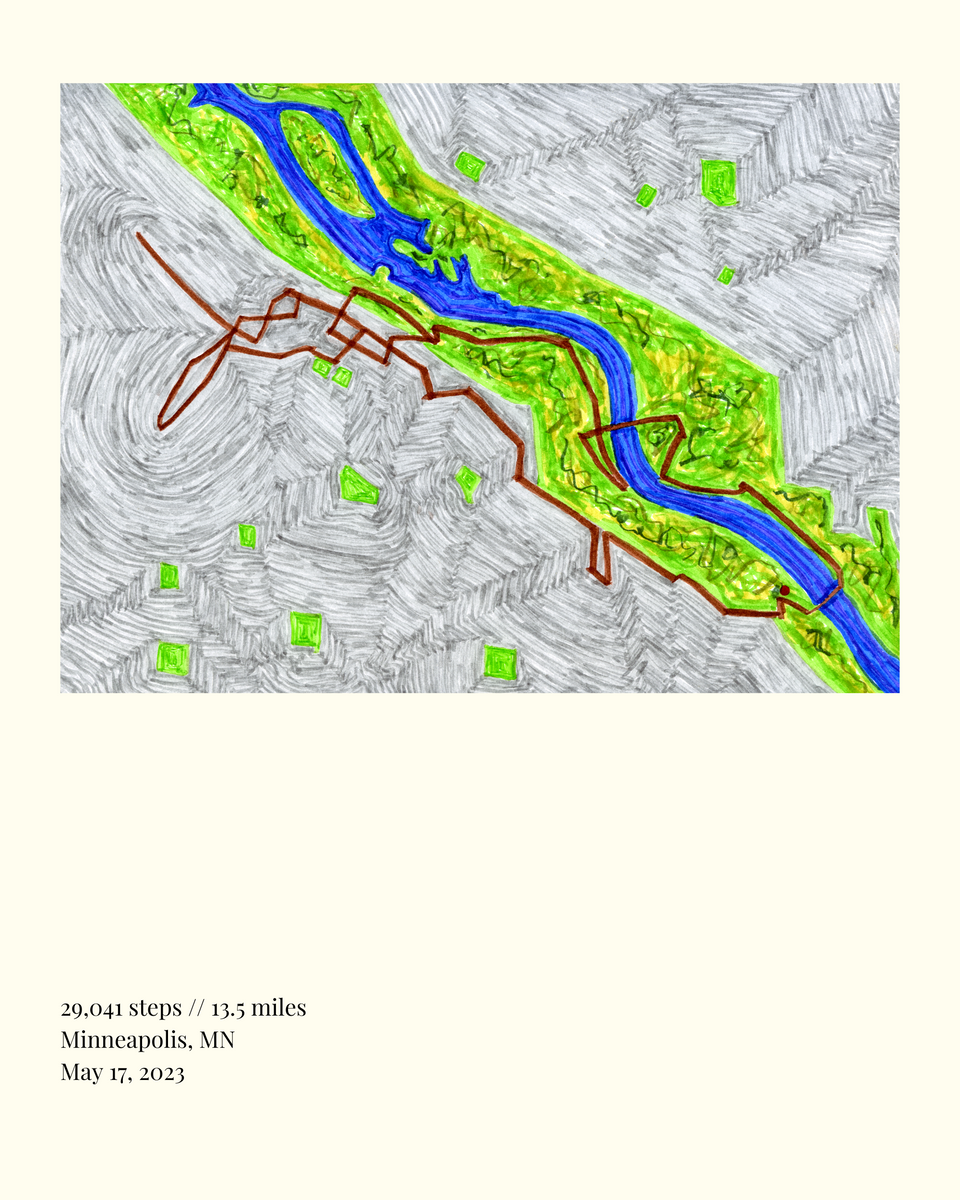
A few years ago, I distinctly remember reviewing the annual Land Trust survey of the best parks in the USA. Unexpectedly, Minneapolis and St. Paul secured the first and second spots that year.
This news struck a chord with me - I had a growing interest in city park systems, and here was the largest city in my home state, boasting one of the most renowned. This realization was not just a source of pride, but a moment of serendipitous insight.
Upon my return to Minnesota a few years later, one of my primary objectives crystallized - it centered on the park system of the Twin Cities. I was determined to traverse and map the expansive green spaces of 'the cities,' aiming to experience the underlying infrastructure and understand the interconnection of these parks within the broader urban landscape.
Last summer, this pursuit led me to reacquaint myself with some familiar paths from my days living in Minneapolis back in the early 2000s. It felt like retracing the steps of the past onto a new map of the future.
This year, the focus of all my walks has shifted towards nurturing novelty. I am intrigued by the possibility of employing mindfulness and soft fascination to transform each walk into a unique experience.
From a particular philosophical standpoint, one could assert that every walk, indeed every moment, is novel - and that's undoubtedly true! The peculiar aspect of novelty is that once you embrace it, you realize its boundless nature, provided you're willing to acknowledge it.
My primary interest on these creative walks lies in experiencing and documenting those unexpected moments of incongruity, when I recognize something new in the landscape or identify a moment as a fresh perception or idea. It's a captivating subject, and while I wish I could claim a full understanding of it, the truth is, it's primarily guided by intuition.
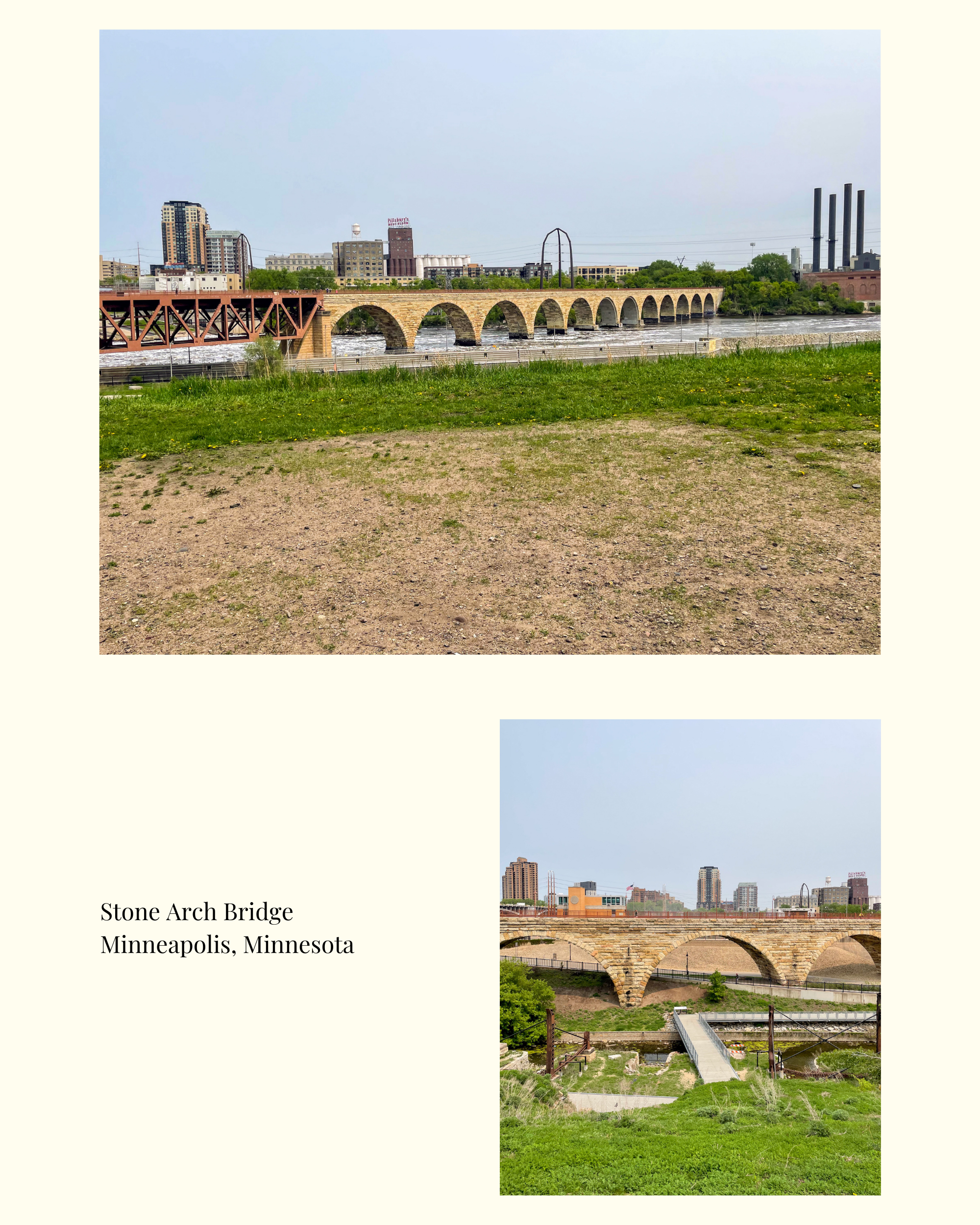
My daily walks in Saint Cloud have been illuminating so far, yet what I truly yearned for was the novelty of an entirely unexplored landscape and walking route. Minneapolis promised ample quantities of both.
Consequently, earlier this year, I planned a four-day visit to the city, dedicating one day specifically for a collaborative walk with the artist and dear friend, Alex Wolfe.
The journey from Saint Cloud to Minneapolis via public transportation necessitates an early start. I boarded a local bus to the primary metro station, where I then caught the 'Link'. This is a bus service that transports passengers from Saint Cloud to Big Lake, marking the first stop on the Northstar commuter line. This line meanders through the northern suburbs of the Twin Cities and culminates its journey at Target Field in Minneapolis.
The bus was remarkably bustling for a Wednesday morning. As we stopped at each station, I found myself captivated by the sprawling apartment complexes that surrounded us. It crossed my mind that residing in one of these and commuting downtown would be an interesting routine if you wanted equal amounts of suburbia and city life.
By the time I reached Target Field, it was around 8:15 AM, yet my room in the hotel located in the Mill District of Downtown wouldn't be ready until approximately 2 PM. Understanding it was time to embark on my first walk, I felt instinctively drawn towards an improvisational stroll along the West Bank of the Mississippi.
Despite operating on roughly three hours of sleep, I felt a surge of energy. Disruptions in my routine, particularly those requiring an early start, tend to trigger my insomniac tendencies.
However, being on vacation, I knew I could afford a nap if necessary. Interestingly, there have been instances when a scant amount of sleep seemed to heighten my alertness.
Equipped with a cup of coffee and the quest for novelty, I was confident I had enough energy to undertake the walk. Moreover, it was a picture-perfect day in Minneapolis.
Solvitur ambulando!
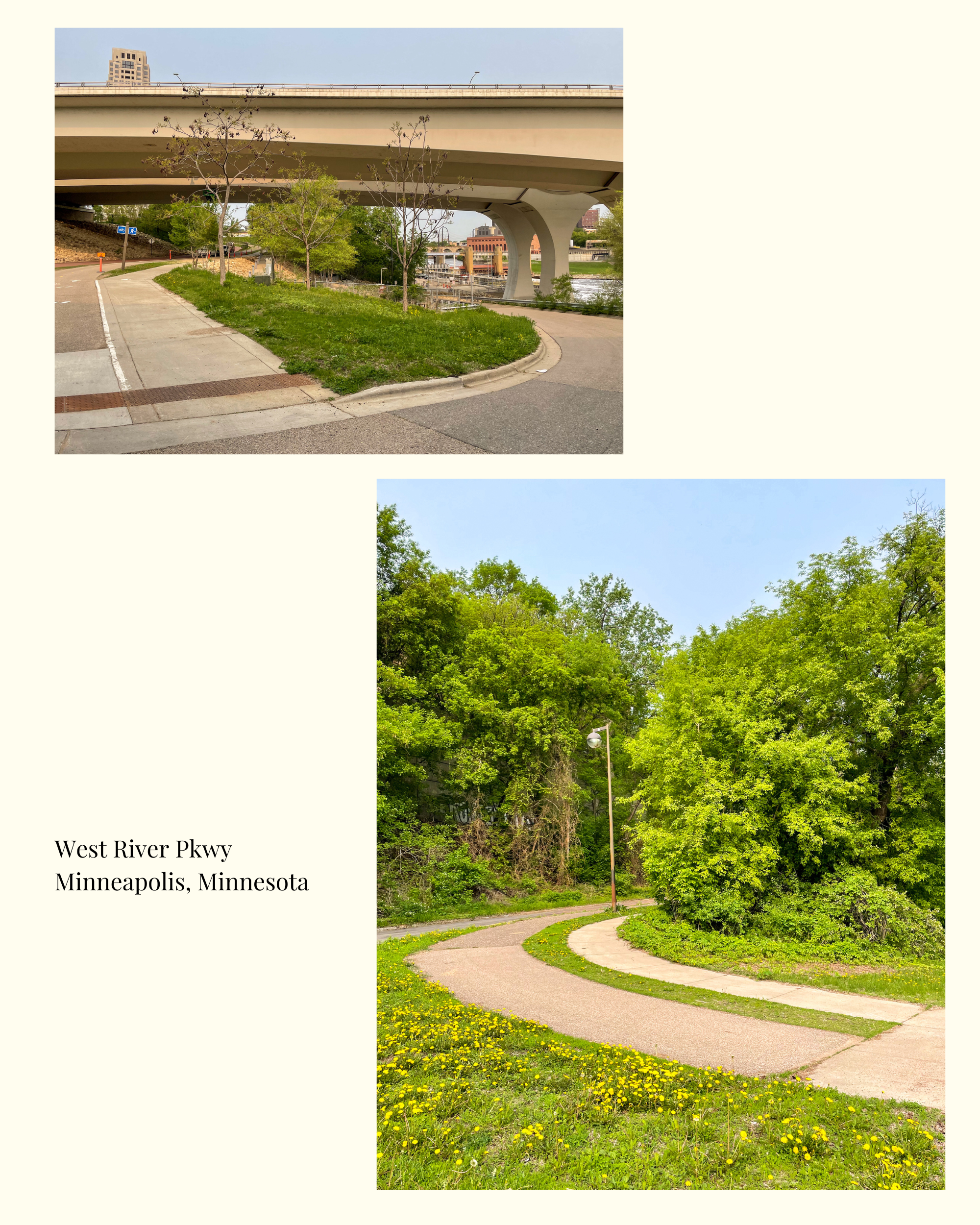
The first 30 minutes of a novelty walk are an intense rush of sensations and ideas. It's nearly impossible to articulate or mediate. Photographs are necessary forms of documentation for me but sometimes there's a really interesting piece of infrastructure or scene that just won't render in a photograph.
There are limitations to the medium that are often frustrating which is why I just don't fight it anymore. A photograph can serve many different functions and purposes, and at this point, I simply refuse to divide them up between what I know might be aesthetically pleasing, and what might simply be a form of note taking.
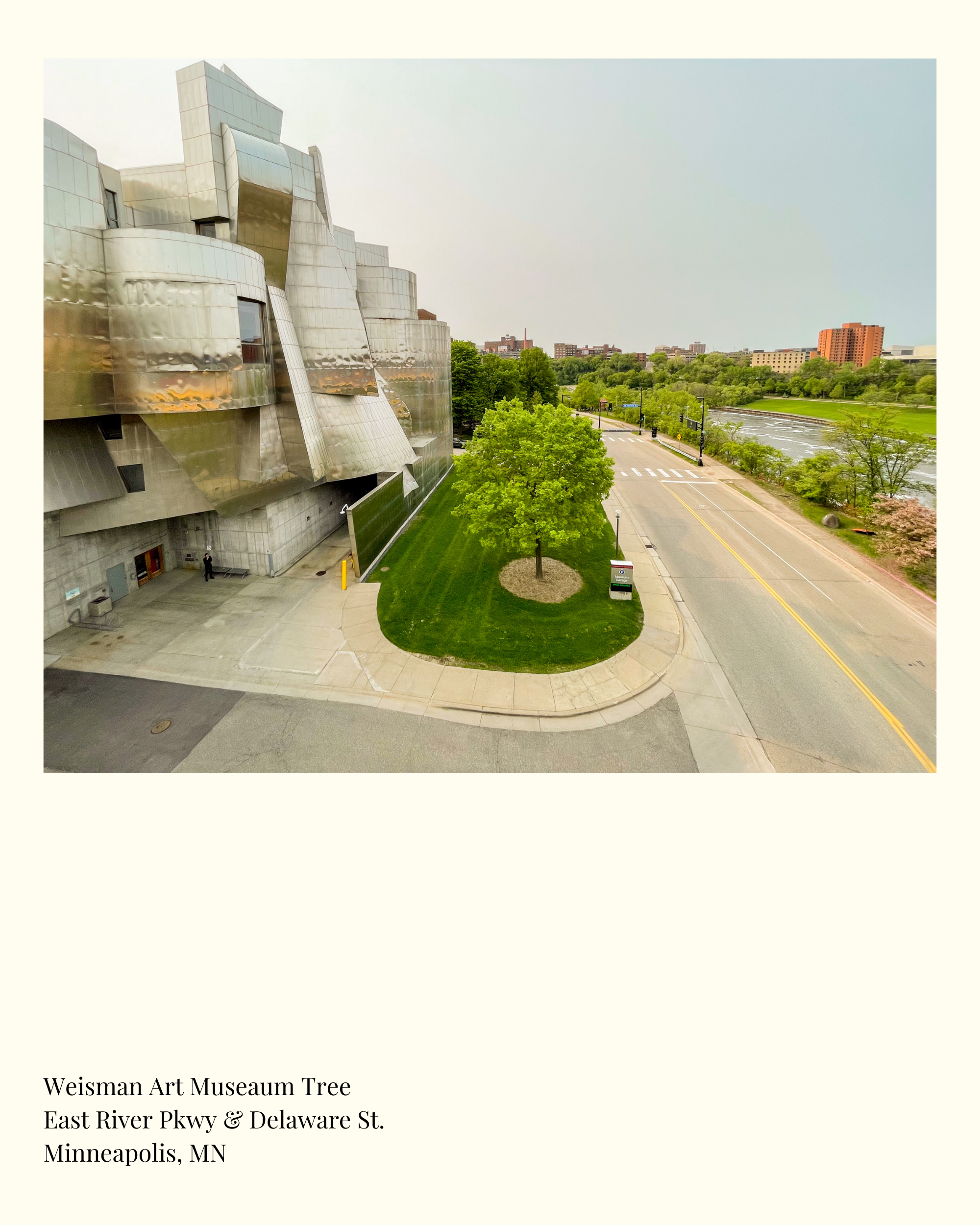
In Minneapolis, the Washington Avenue Bridge accommodates the Light Rail line on one deck and extends a partially covered pedestrian and bike path on another, leading over to the East Bank.
As you cross, an awe-inspiring view of the Weisman Art Museum unfolds, a masterpiece designed by Frank Gehry. Although I haven't yet attended any exhibitions, it has certainly earned a spot on my to-visit list.

The East River Flats Park guides you right along the Mississippi. There's something quite mesmerizing about arriving at these junctions in the pathways, where they carve out pristine shapes in the grass. It's genuinely marvelous.
I sauntered along the river loop for a few minutes until I encountered a roadblock. A sign indicated that the river's heightened level made proceeding any further unsafe. Looking around, I spotted an intriguing set of stairs ascending a tree-lined slope.
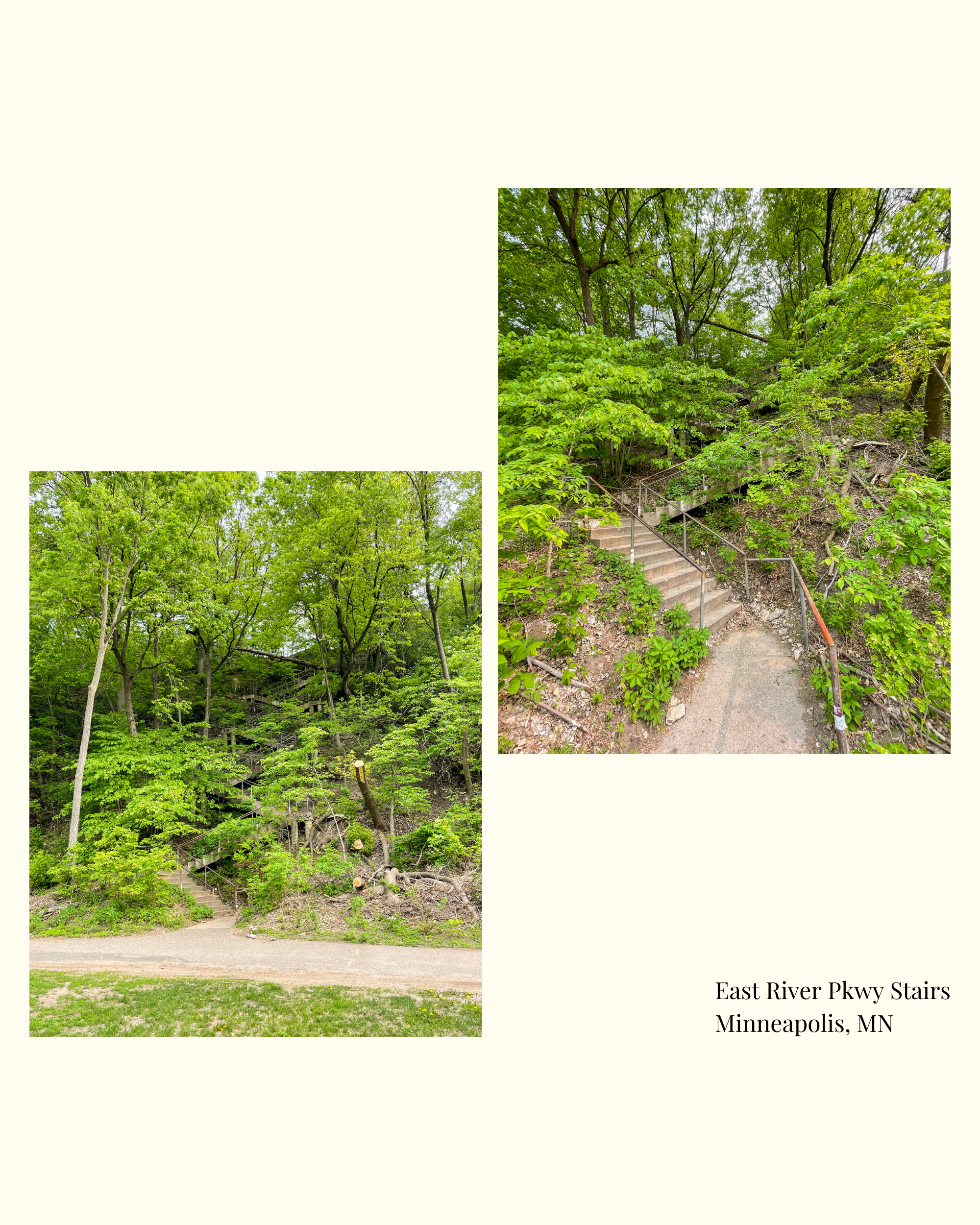
Discovering steep, zigzagging stairs that cut through the woods is an unusual occurrence on my walks. Stumbling upon one during this particular walk seemed like an auspicious indication that my pursuit of novelty was unfolding as planned.
As I climbed, I found myself slightly winded, and my attention was drawn to some agitprop graffiti adorning a few of the steps, which I thought was brilliant. I rarely photograph that type of art because it's best experienced in situ.
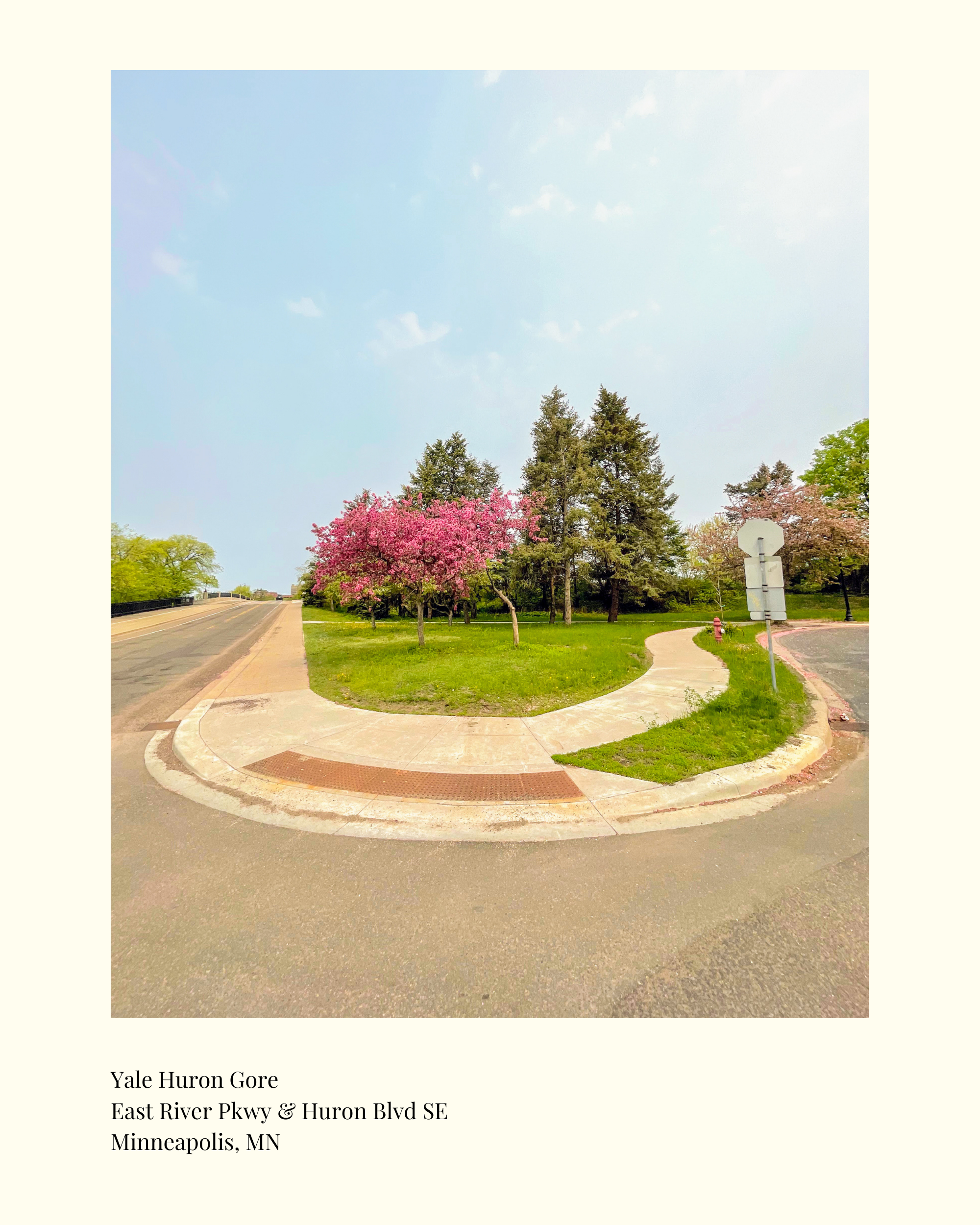
In the context of urban planning and geography, a gore is a small, often triangular piece of land that is left over after roads or property lines are laid out. It's typically an irregular or leftover piece of land that may be too small for development, situated between intersecting streets, highways, or property boundaries.
This particular gore was impossible to ignore, primarily due to its vibrant colors. I often find myself circling these a few times to immerse myself in the space and take in the different perspectives they offer. They pique my curiosity as public green spaces, prompting the question: what can you really do with these spaces?
On the surface, not much, and yet, it's astounding how prevalent they are, largely due to city designs oriented around cars, which inevitably lead to plenty of cut-off and leftover green spaces. When you consider them collectively, you realize they play a vital role in bridging pedestrian infrastructure with green spaces.
Having added this one to my map, I am eager for my next visit.

Crossing the Franklin Bridge and returning to the West Bank, I was en route to Murphy Square when I stumbled upon the 'Site of the Oldest Tree in Minneapolis.' This startling juxtaposition incited a feeling of being drawn to the location by the surrounding trees, almost as if to pay a visit to this sacred memorial.
There's a peculiar phenomenon that occurs when you're engrossed in the landscape and aware of the type of locations you wish to explore. This forms part of the sheer joy of a lengthy novelty walk. You permit the narrative to evolve organically, letting your instincts guide you towards the next landmark.
The urban landscape never fails to present something to capture my fascination, offering almost limitless opportunities to reflect on and engage with the built environment.
Minneapolis, with its abundance of green spaces and water, was designed to provide an immersive natural experience. It was during this trip, through these walks, that I truly grasped the ingenuity of the Minneapolis park system.

Following that encounter, it seemed fitting that my next destination was Murphy Square, the oldest and first park in Minneapolis. While the original dedication plaque in the center of the park was no longer there, a few interpretive panels scattered around provided an overview of the park's history.
Positioned across the park was an entrance to a pedestrian overpass that bridged I-94. I ventured onto the bridge for a few moments, absorbing the distinctly dystopian atmosphere wrought by pervasive car culture, before continuing on my way back to the hotel.
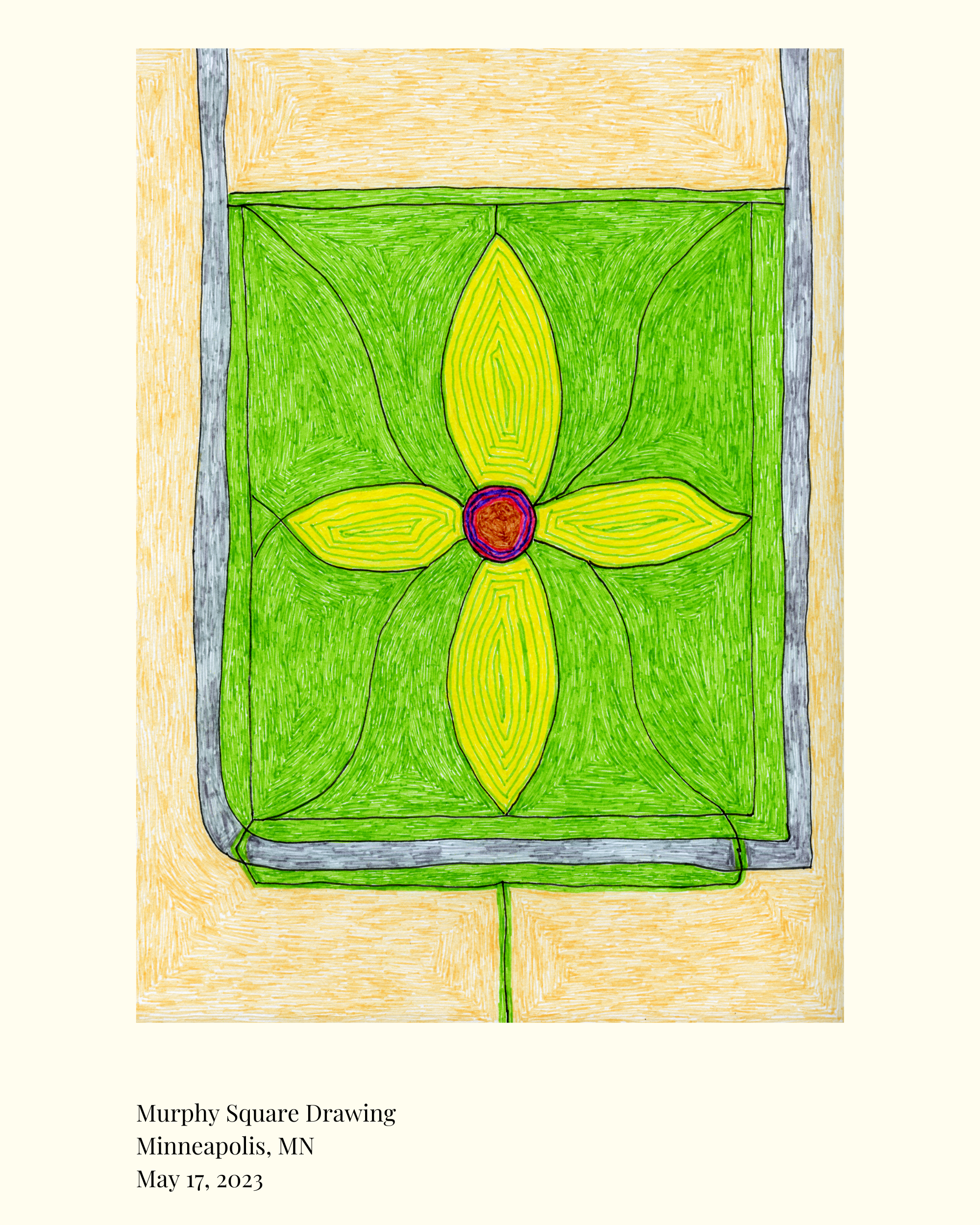
My day concluded at Brit's Pub, where I shared a few beers with a college friend whom I hadn't seen in several years.
The day was a blend of novelty and nostalgia, and I suppose that giving form to such experiences through these articles is the initial step towards creating an archive. Where that intersects with the ambition to shape the material and ideas into art represents a significantly larger challenge.
As I've aged, I've begun to question how much manipulation needs to occur, or if I even possess the drive to propel these ideas forward. Perhaps a simple collection of photographs and maps is all I truly need.
Inspiration
- Walking might be good for you, but it also ruins your life: 'And as walking thinkers we understand that the only way to coordinate mind and body is through deception. When you walk, the truth appears, annoying and inevitable, and all the fantasies about eternal youth and bodily perfection become vain. You do it because you have to, because the alternative is terrifying, but don’t infantilize us with self-deceptions that are not appropriate for an adult. We were happier before. To live with the knowledge that all that is over may make us wiser, maybe even exemplary, but also a bit Sisyphean and mechanical. Somehow, we are less human, and as the population pyramid is inverted, soon we will almost all be old people walking in the parks and the future will be stripped of humanity — paler, with elegiac music, closer to Shostakovich’s melancholies than to Beethoven’s outbursts. We will be wiser too. But we will be shit."
- How to Quit Cars: "We pay an enormous price for our automotive addiction—in congestion, time wasted, neighborhoods destroyed, emissions pumped out, pleasant streets subordinated to brutal expressways—but telling the addict that the drug isn’t actually pleasurable is a losing game. There is some slight hope in saying that it isn’t healthy, and that the replacement for the drug is about as good. But understanding this emotional infrastructure in favor of cars is vital to imagining their possible replacement. The grip of the car as a metaphor for liberty is as firm as that of guns, if perhaps with similarly destructive results.”
- Let the Postpandemic City Grow Wild: "Cities often contain perfected, simplified forms of nature, ones that look pretty but are biologically impoverished. But forget parks, neat and tidy as they are. Nature at its insurgent best insinuates itself in the gaps in the urban fabric: the soggy, unloved floodplain of Dallas, but also abandoned lots, roadsides and intersections, railroad lines, mortared walls, empty malls, disused factories, the edges of chain-link fences and the cracks in the concrete. This is where we find the rough, tough vegetation and wildlife, adapted to living in proximity to us, seemingly against the odds. It is not the nature you might find in a national park, and that is why it is worth celebrating: for its sheer ability to survive and thrive in a hostile environment and nurture other life."
- Where we are - The Park: Located to the west of Downtown Los Angeles, the Vista Hermosa Natural Park is a pocket of rolling woodlands that cradle streams and lush meadows. It has always been a space of community, peppered with picnic areas, a playground and an amphitheater. But during the pandemic, when so many other gathering places were closed, its power came into focus for Rory, who is nonbinary and uses they/them pronouns, and the other queer and trans young adults in their cohort. Meeting at the park was therapeutic for the group, allowing them to express themselves and learn from one another in a safe, intimate space. The tradition has extended beyond the pandemic. “It’s a community that we’ve been looking for and been trying to find and build for ourselves in L.A. for as long as we can remember,” Alè Bersanetti, 24, said. “Just how affirming and natural and just how seen you feel in a friendship, how deep those connections are. It’s really special.”
I’m an artist and marketing strategist from Saint Cloud, Minnesota. This is my newsletter on art, walking, urbanism and mindfulness.
Each issue, I share new work from my projects and try to make connections between ideas, articles and people that fascinate me. You can email me at info@bryanformhals.com or follow me on Instagram.